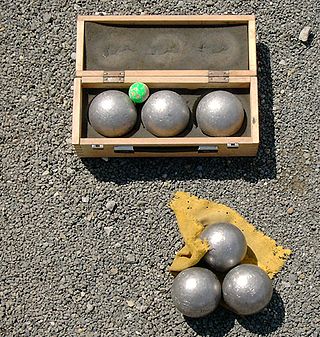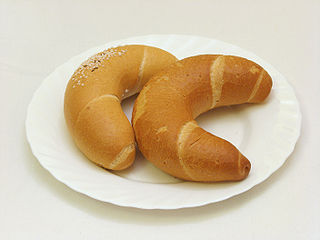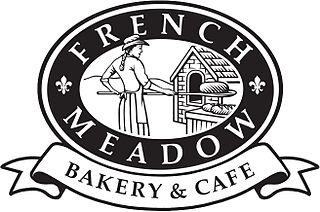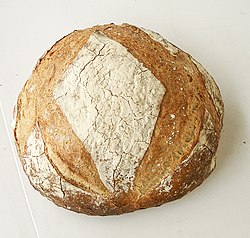
Bread is a staple food prepared from a dough of flour and water, usually by baking. Throughout recorded history and around the world, it has been an important part of many cultures' diet. It is one of the oldest human-made foods, having been of significance since the dawn of agriculture, and plays an essential role in both religious rituals and secular culture.

Boules, or jeu de boules, is a collective name for a wide range of games similar to bowls and bocce in which the objective is to throw or roll heavy balls as closely as possible to a small target ball, called the jack. 'Boules' itself is a French loanword that usually refers to the game especially played in France.

A croissant is a French pastry in a crescent shape made from a laminated yeast dough similar to puff pastry.

Sourdough or sourdough bread is a bread made by allowing the dough to ferment using naturally occurring lactobacillaceae and yeast before baking. The fermentation process produces lactic acid, which gives the bread a sour taste and improves its keeping-qualities.

A baguette is a long, thin type of bread of French origin that is commonly made from basic lean dough. It is distinguishable by its length and crisp crust.

Kringle is a Northern European pastry, a variety of pretzel. Pretzels were introduced by Roman Catholic monks in the 13th century in Denmark, and from there they spread throughout Scandinavia and evolved into several kinds of sweet, salty or filled pastries, all in the shape of kringle.

Kipferl, kifli, kiflice, or kifle is a traditional yeast bread roll that is rolled and formed into a crescent before baking.

A bear claw is a sweet, yeast-raised pastry, a type of Danish, originating in the United States during the mid-1910s. In Denmark, a bear claw is referred to as a kam. France also has an alternate version of that pastry: patte d'ours, created in 1982 in the Alps. The name bear claw as used for a pastry is first attested in March 1914 by the Geibel German Bakery, located at 915 K Street in downtown Sacramento. The phrase is more common in Western American English, and is included in the U.S. Regional Dialect Survey Results, Question #87, "Do you use the term 'bear claw' for a kind of pastry?"

Cuban bread is a fairly simple white bread, similar to French bread and Italian bread, but has a slightly different baking method and ingredient list ; it is usually made in long, baguette-like loaves. It is a staple of Cuban-American cuisine and is traditionally the bread of choice when making an authentic Cuban sandwich.

In cooking, proofing is a step in the preparation of yeast bread and other baked goods in which the dough is allowed to rest and rise a final time before baking. During this rest period, yeast ferments the dough and produces gases, thereby leavening the dough.

Vienna bread is a type of bread that is produced from a process developed in Vienna, Austria, in the 19th century. The Vienna process used high milling of Hungarian grain, and cereal press-yeast for leavening.

French Meadow Bakery is a privately held bakery located in the Uptown neighborhood of Minneapolis that produces gluten-free, vegan, yeast-free and kosher parve foods. It is one of the longest running certified organic bakeries in the country. The bakery is currently certified organic by the USDA and Quality Assurance International, certified Gluten-Free by the Gluten-Free Certification Organization, and certified Low Glycemic for Diabetics by the Glycemic Research Institute.
The history of California bread as a prominent factor in the field of bread baking dates from the days of the California Gold Rush around 1849, encompassing the development of sourdough bread in San Francisco. It includes the rise of artisan bakeries in the 1980s, which strongly influenced what has been called the "Bread Revolution".
Bread is a staple food throughout Europe. Throughout the 20th century, there was a huge increase in global production, mainly due to a rise in available, developed land throughout Europe, North America and Africa.

Pan dulce, literally meaning "sweet bread", is the general name for a variety of Mexican pastries. They are inexpensive treats and are consumed at breakfast, merienda, or dinner. The pastries originated in Mexico following the introduction of wheat during the Spanish conquest of the Americas and developed into many varieties thanks to French influences in the 19th century.

Concha, plural conchas, is a traditional Hispanic sweet bread with similar consistency to a brioche. Conchas get their name from their round shape and their striped, seashell-like appearance. A concha consists of two parts, a sweetened bread roll, and a crunchy topping. The most common crunchy topping flavors being chocolate, vanilla, and strawberry. Conchas are commonly found throughout Mexico and Guatemala in panaderias. They can now also be found in grocery stores and bakeries across the United States.

Jerusalem bagel or Jerusalem Ka'ak is a type of bread baked in Jerusalem. It has a ring shape but is otherwise unlike a traditional boiled bagel.















